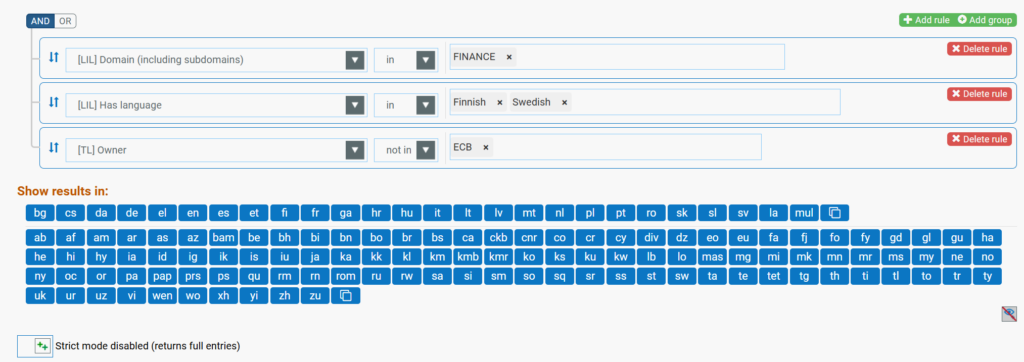The ‘Advanced search’ ☍ feature enables you to refine your terminology searches to better match your specific needs, with filters to narrow down results. Here are some tips and examples to help out make the most out of the advanced search in IATE.
On this page, you will find information about:
COMMON QUERIES
Here are some examples of common queries that might be of interest to you:
- Export based on a collection, containing only terms with reliability 3 and 4 in English – strict match.

- My language (DE) missing from a collection. Visualisation of results in the available EU languages.

- Entries in a certain domain containing both EN and HR. Visualisation limited to those languages.

- Entries in a certain domain containing either Finnish or Swedish (or both of them), excluding terms from certain institutions/bodies. Visualisation of all available languages in the entry.

- Primary entries where a particular language (FR) is missing. Visualisation of all available languages in the entry.

- Terms (TL) created in a certain time period by COM users in a particular language (EN). Strict visualisation (only those terms will be retrieved, not their synonyms belonging to other users or having been created outside the selected period).

- LLs created after a certain date by Council users in a particular language (ES). Visualisation of full content of the entries in Spanish and English.

- Entries where a particular language is the anchor language (EN) and this language does not have a definition. Visualisation of EN LLs.

- Particular language (DA) TLs with reliability 1 or 2. Visualisation of Danish language (non-strict, all terms under DA will be displayed).

- Entries having a certain text in term reference fields of a certain language (BG). Strict visualisation, only those BG TLs will be retrieved.

REGULAR EXPRESSIONS
You can run more advanced searches using a specific regular expression syntax, offering you many combination possibilities. Here are some examples of how to use regular expressions and what you can do with them:
| Action | Regular expression |
|---|---|
| Begins with ‘e’, ends with ‘n’ | e.*n |
| Begins with ‘e’, ends with ‘n’ with maximum 1 letter in the middle | e.?n |
| Begins with ‘e’, ends with ‘c’ with 2 letters in the middle | e(.?){2}c |
| Begins with ‘european’ | european.* |
| Contains a word that ends with ‘e’ followed by a word that starts with ‘d’ | .*e d.* |
| Begins with a word that begins with ‘e’, ends with ‘n’ with 6 letters in the middle | e(.?){6}n .* |
| Contains ‘europe’ | .*europe.* |
| Contains the word ‘viral’ or ‘virus’ | .*vir(al|us).* |
| Contains the word ‘italy’ or ‘france’ | .*(italy|france).* |
| Contains both ‘belgium’ and ‘luxembourg’, in this order | .*belgium.*luxembourg.* |
| Contains both ‘spain’ and ‘germany’ in any order | .*(spain.*germany|germany.*spain).* |
| Contains two times the word ‘europe’ in it (and starts with Europe) | (europe.*){2} |
| Contains two times the word ‘europe’ in it (either at the beginning or not) | .*(europe.*){2} |
| Contains ‘france’ or ‘italy’ (either both, or one of them repeated) | .*((france|italy).*){2} |
| Contains a number | .*[0-9].* |
| Does not contain a number | [^0-9] |
| Contains a number with at least 2-digits | .*([0-9]){2}.* |
| Is composed by a character which is not a number, followed by a number, followed by a character which is not a number | [^0-9]([0-9])[^0-9] |
| Contains only one number, with exactly 3-digit | [0-9[^0-9]*([0-9]){3}[^0-9]* |
| Contains only numbers | [0-9]* |
TIPS ON IATE FIELDS
Depending on the level you select when creating a rule or a group of rules, there are some aspects that you should keep in mind:
At LIL :
- LIL Belongs to collection: very useful field for termbases. The drop-down list is not complete, given the high number of collections, but you can find a collection by writing its name in the empty cell. This field can be used together with the ‘Collection type’ field.
- LIL Domains: If you want to search only for entries with the exact domain that you select here, use ‘Domain (exact)’. If you want to search for entries with that domain or any of its subdomains, use ‘Domain (including subdomains)’. Please note that the drop-down list is just a short excerpt of EuroVoc domains, and not really useful as it is. Check in EuroVoc or with the basic search mode first, to find the domain you want to use. The only way to find the domain here is to write the keywords in the empty box.
- LIL Entry ID: you can insert a long comma-separated list of entry numbers here, maximum 5 000 LIL IDs at a time.
- LIL Has language: means that the entry contains a specific language. Do not confuse with LL/TL belongs to language, which is used to target your search to a certain language.
- LIL Primarity: whether an entry is a primary or not (yes – no).
At LL:
Whenever you search for something in LL or TL, specify the language with the rule ‘LL/TL Belongs to language’. If you don’t use this rule, the search is targeted to all EU languages (non-EU languages are excluded to optimise the query).
;)
